|
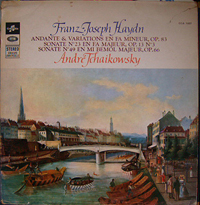
Columbia Records Cover Art
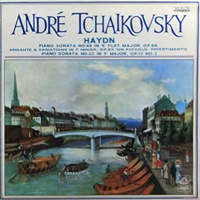
Angel Records
Cover Art
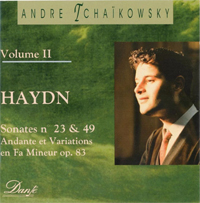
Reissue
Danté Cover Art
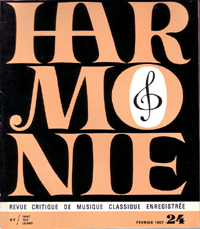
Harmonie
Magazine Review
February 1967
Click Here - in French
Click Here - in English
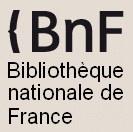
Click
Here - BnF Reference
|
Columbia
Records (EMI Pathé Marconi) CCA-1097
Angel (Toshiba/EMI) AA-8176 (Stereo)
Reissue - Danté Records, HPC029 - Vol. 2
Haydn Recital
Music/MP3:
Haydn - Sonata No. 49 in mib majeur, Opus 66
1. Allegro
/ 01_haydn_opus_66_sonata_49_1st.mp3
2. Adagio e cantabile / 02_haydn_opus_66_sonata_49_2nd.mp3
3. Finale: Tempo di Minuet / 03_haydn_opus_66_sonata_49_3rd.mp3
Haydn - Andante et variations en fa mineur, Opus 83
Andante
et variations / 04_haydn_opus_83_variations.mp3
Haydn - Sonata No. 23 in fa majeur, Opus 13, No. 3
1. Allegro
moderato / 05_haydn_opus_13_no_3_sonata_23_1st.mp3
2. Adagio / 06_haydn_opus_13_no_3_sonata_23_2nd.mp3
3. Finale - Presto / 07_haydn_opus_13_no_3_sonata_23_3rd.mp3
Recording
Date(s):
January 4 to 7, 1966
Recording
Location:
Salle Wagram, Paris, France
Release
Date:
1966
Harmonie
Magazine Review (February 1967):
Three Haydn scores are among the most frequently recorded. The 23rd
Sonata (1773) is a perfect example of the stylistic diversity of the
times, at the beginning of the Classical era: already written in gallant
style, but also with broken and jerky lines in the manner of Carl Philipp
Emmanuel Bach and of the Sturm und Drang movement, arpeggiated
chords and long passages in minor in an overall context of major. On
the other hand, the 49th Sonata (1790) and the F minor Variations (1793),
two of the masterpieces for piano of their days, are representative
of the composer's highest maturity. The 49th Sonata, lighter, more Mozartean
in style than the three last ones, culminates in its magnificent Adagio
cantabile; as for the F minor Variations, they are in fact a double
series of variations, alternately in minor and major - an typical formula
of Haydn.
In the
49th Sonata, among André Tchaikowsky's most notable predecessors
were Richter (Chant du Monde), Riefling (Valois) and - for me unforgettable
but unfortunately now almost impossible to find - Lili Kraus (Ducretet).
I think he takes the upper hand - at least on the two first-mentioned:
a commendable result given their merits. But Richter made one repeat
too much in the opening Allegro; and Riefling shows less depth, less
poetry than André Tchaikowsky today. Not that the qualities of
the Polish pianist are limited to that: at his hands the 49th Sonata
sounds spacious, grand, contrasted; the middle, minor episode in the
Adagio cantabile, with its opposing registers, is one evidence among
others. Worthy of note is also, in the F minor Variations, the choice
of a right tempo : not too flowing, which remains the only way to do
justice to the numerous 64th notes in some of the variations.
Highly
recommended then, especially to those who do not yet have, in their
music library, any music for solo piano by Esterhazy's Kapellmeister.
Marc
Vignal (Trans. Edouard Reichenbach)
Known
Details
Just about the time this recording was made, André was moving
into his own home at 29 Waterlow Court, Hampstead, London. From the
book,
The Other Tchaikowsky.
One of
André's first possessions for his new home at 29 Waterlow Court,
Hampstead, was a 6-foot Steinway grand piano, purchased on an extended
time-payment plan. With his home thus established, André started
to practice, and the complaints began. His neighbor next door worked
nights and wanted quiet during the day. His neighbor upstairs went to
bed early and was a light sleeper; she wanted quiet during the evening.
Nobody wanted to hear piano playing into the early hours. There was
talk of a petition to have André evicted. John M. Thomson, a
New Zealander who was then Music Books editor for Faber & Faber,
was André's neighbor. John remembers André and the Waterlow
Court scene:
"I
first met André Tchaikowsky when I moved into a small flat
on the upper floor of Waterlow Court in Hampstead in the 1960s. André
lived in a ground-floor flat, very small indeed for his requirements,
for it housed his grand piano, books and scores. It consisted of one
main room looking out onto the courtyard and gardens at the side,
a separate small bedroom, and a bathroom. This was the basic pattern
of all the flats in the Court.
"The
Court itself was a distinguished piece of Edwardian architecture,
designed by the eminent architect Baillie Scott. It was modeled on
a north Italian monastery, with its cloisters running around three
sides, its bell tower and its overall atmosphere. This was the only
example of Baillie Scott's work in the Hampstead Garden Suburb, which
had been founded by Dame Henrietta Barnett around 1906. Her vision
was to provide a wide variety of types of housing in a superb setting
abutting the Hampstead Heath Extension, only a minute or two away
from the Court and connecting into the Heath proper.
"I
suspect that one reason André decided to live there was its
proximity to the Heath, with refreshing walks at a moment's notice.
He loved the Heath and I often walked with him while he commented
on its beauties.
"The
Residents' Association was very powerful, especially one of the members,
a Miss Cubison, who lived two floors above André and therefore
tended to hear him practicing. She was a formidable lady and bowled
over almost everybody, including myself. André told me how
she appeared at his door one day, after he had practiced far into
the night, and almost roared at him, 'Have you no human feelings,
Mr. Tchaikowsky?' André invited her in and so charmed her that
she set aside the petition she was circulating to have André
evicted. It was an insuperable problem, for André practiced
regularly and when he was working on big works such as the Hammerclavier
Sonata by Beethoven, he would toil away almost as if he were about
to ascend Everest. He also worked very late when he was composing.
"We
would walk outside the Court into Hampstead Village on innumerable
occasions. An instance of his spontaneous generosity was once when
he went into a record shop in Hampstead, and knowing my love of Haydn,
bought me the set of 'London' symphonies conducted by Eugene Jochum,
which I still have and treasure.
"I
knew of his love affairs, exclusively male, their dramas and occasional
successes.
"He
once asked me what the 'M' in my name stood for. 'Marmaduke' I replied.
He often called me by this name. When I visited him backstage unexpectedly
after a recital in 1980 in the old Town Hall in Wellington, New Zealand,
he shouted it out 'Marmaduke!' to the astonishment of my friends!
"André
used to bring his autobiography and read it to me. He had such a tragic
past that anything therapeutic, like writing the autobiography, one
simply had to seize on. I once went to a concert he gave at one of
the London satellite towns and met his mentor, the famous psychologist
George Lyward, who ran a school. André always considered Lyward
to have saved his life and restored his perspective and sanity.
"There
was a tremendous fund of stories about artists and conductors. He
once had to play a piano concerto with Karl Böhm conducting and
there was a contretemps. André stuck to his guns until Böhm
said, 'I have conducted this concerto 154 times.' André replied,
'That's 153 times too many,' whereupon Böhm strode angrily offstage
and André didn't know whether or not he would appear for the
performance. [He did.]"
The uneasy
alliance between André and his neighbors at Waterlow Court continued
for the entire ten years he lived in Hampstead.
|




